Lost Belgian beers: Keute from Namur
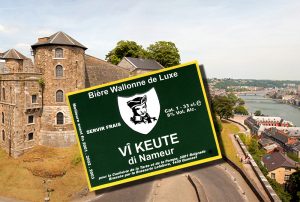 Namur, capital of the French-speaking part of Belgium known as Wallonia, is where the Brussels Beer Challenge started today. 85 beer judges will taste over 1400 international beers. However, I already was in Namur last week, where I stumbled upon an old friend: kuit beer. Time to rewrite a part of this Dutch beer’s history…
Namur, capital of the French-speaking part of Belgium known as Wallonia, is where the Brussels Beer Challenge started today. 85 beer judges will taste over 1400 international beers. However, I already was in Namur last week, where I stumbled upon an old friend: kuit beer. Time to rewrite a part of this Dutch beer’s history…
If there is one country that still has to reveal its historical beer secrets, it is, oddly, Belgium. And so I came to Namur. It’s not Wallonia’s biggest city: both Liège and Charleroi have almost twice as much inhabitants. Because in 1986 those two cities could not agree which should be the capital of Francophone Belgium, in the end small Namur got the gig.
The city is dominated by the citadel, an enormous fortress situated high above the confluent of the Meuse and Sambre rivers. This strategic position made Namur a garrison town for much of its existence, and several times it was besieged and bombed, and several times it had to rise again from its ashes. And often it was inhabited by thirsty soldiers.
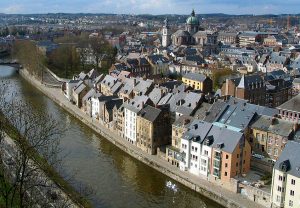 Like its name suggests, the Rue des Brasseurs housed about thirty breweries which provided citizens and soldiers with fresh pints. At their back, the breweries were all located right on the Sambre river, from where they obtained their brewing water. Although the last brewery closed long ago, this is still very easy to spot.
Like its name suggests, the Rue des Brasseurs housed about thirty breweries which provided citizens and soldiers with fresh pints. At their back, the breweries were all located right on the Sambre river, from where they obtained their brewing water. Although the last brewery closed long ago, this is still very easy to spot.
Around the year 1350, people in Namur still drank ‘cervoises forte et floible’, or strong and weak gruit beers. However, a 1388 document mentions other new grain beverages, called ‘houppe’ and ‘thibut’. The latter quickly disappeared, but in the ‘houppe’ we can recognise imported ‘hoppenbier’ (hop beer) from Holland.[1] Thus, just like the cities of Flanders, in particular Bruges and Gent, also Namur was reached by the brewers of especially Haarlem.
And that was not all: the brewers of Namur, just like elsewhere in what is now Belgium, started brewing with hops as well, so that in 1465 a guidelines were written for the brewing of ‘houppe’: it had to be made with 5 almuds of spelt or rye per 24 barrels of water, with the ‘corresponding’ amount of hops.[2] However, the hoppenbier from the north was not the only beer that gained popularity in the Southern Netherlands, and so in 1488 we see ‘queute’ or ‘keute’ surface in Namur.[3] In this, we can of course recognise the popular kuit beer, for which especially the city of Gouda was renowned, and which was eagerly copied in what is now Belgium. Kuit beer was slightly less hopped and paler in colour than hoppenbier.
Around the year 1500 houppe, keute and ‘forte keute’ (strong keute) were the three beer types made in Namur. By that time houppe had become the cheapest variety, at 15 sous a barrel, while a barrel of keute cost 30 sous and forte keute no less than 45 sous. Just like elsewhere in the 16th century, a strong ‘beer inflation’ took place, in which the various beer types all became weaker and weaker and some of them would eventually disappear. In 1502 houppe still represented 34,5% of total production in Namur, but by 1535 it was completely extinct. In the latter year, keute accounted for more than 80% of production, but after 1550 it almost completely gave way to the forte keute, which in the end remained the only beer type of Namur.[4]
To summarise, Namur too came under the spell of the successful kuit beer, just like the towns of Flanders and Brabant, like Gent, Antwerp and Brussels (and also Halle, where a ‘keute et houppe’ recipe was documented in 1559, which 20th-century amateur historians wrongly took for a lambic recipe).[5] Brewing village Hoegaarden made a ‘keute de hougarde’ as well, which is found in the Namur archives.[6]
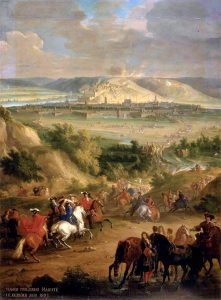 Anyway, all this is of course very nice, but still nog really surprising. However, there is more! The name ‘keute’ vanishes from official documents in 1606. After that, the Namur sources only speak of ‘bonne bière’ and ‘petite bière’. Also, the quality of Namur beer diminished: brewers were doing good business in times of war when there were many soldiers in town, but especially in the eighteenth century, things went badly. Well-off citizens apparently only drank white beer from Hoegaarden (imports from this town made up 5 to 15% of consumption in Namur).[7] In the eighteenth century, the beer from Namur itself was made with barley malt, but also with oats and spelt, and often ‘plants, spices and other illegal substances’ were added, such as ‘chalk, sunflowers, calf’s feet, vinegar, salts, agrimony’ and more.[8]
Anyway, all this is of course very nice, but still nog really surprising. However, there is more! The name ‘keute’ vanishes from official documents in 1606. After that, the Namur sources only speak of ‘bonne bière’ and ‘petite bière’. Also, the quality of Namur beer diminished: brewers were doing good business in times of war when there were many soldiers in town, but especially in the eighteenth century, things went badly. Well-off citizens apparently only drank white beer from Hoegaarden (imports from this town made up 5 to 15% of consumption in Namur).[7] In the eighteenth century, the beer from Namur itself was made with barley malt, but also with oats and spelt, and often ‘plants, spices and other illegal substances’ were added, such as ‘chalk, sunflowers, calf’s feet, vinegar, salts, agrimony’ and more.[8]
In the Netherlands, kuit had all but disappeared by this time. Already in the early 17th century it had become hopelessly weak, and by the 19th century, in Haarlem kuit was the name of the most watery type of small beer. But, surprise: Namur was still drinking kuit. That is to say, apparently in the 19th century ‘every good Namurois’ would go and have a mug of ‘keute’ at the Café de l’Europe on the Grand’Place, on Sunday or Monday afternoon after four.[9] Félicien Rops, graphic artist and painter from Namur with a lightly pornographic oeuvre (just look him up on Wikipedia…) described a jolly evening in 1848 with his music teacher, a man called Büch, where they opened ‘three bottles with Namur’s old beer, “del vie Keute”‘.[10]
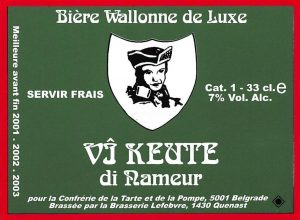 ‘C’est l’vie keute qui nos fait rire’ (‘It’s the old keute that makes us laugh’) is a line from a popular Namur folk song from 1893, and another Namurois, one François Quinaux, wrote a jolly chanson in dialect about a folksy wedding, containing this line: ‘Donez nos dèl viye keûte qui v’s avoz è botèyes’ (‘Give us old keute that you have in bottles’).[11] So yes: apparently in Namur ‘keute’ had survived throughout the centuries, as an old beer!
‘C’est l’vie keute qui nos fait rire’ (‘It’s the old keute that makes us laugh’) is a line from a popular Namur folk song from 1893, and another Namurois, one François Quinaux, wrote a jolly chanson in dialect about a folksy wedding, containing this line: ‘Donez nos dèl viye keûte qui v’s avoz è botèyes’ (‘Give us old keute that you have in bottles’).[11] So yes: apparently in Namur ‘keute’ had survived throughout the centuries, as an old beer!
According to Namur archivist and historian Félix Rousseau the ‘vieille keute’ was a ‘strong beer, a kind of saison, with a bit soury taste. It was brewed in particular in March and was kept for a fairly long time, sometimes one or two years.’ Rousseau writes that the brewers from the Rue des Brasseurs hired space in the cellars under Namur cathedral and the Palace of Justice, to store their barrels of keute. Around 1870 the keute disappeared, he says. This also means that Rousseau, born in 1887, cannot have seen its production with his own eyes.[12]
Unfortunately, not much else is known about Namur’s 19th-century keute. A footnote in Quinaux’ song explains that it was a ‘quite strong brown beer’. Does this mean the keute of Namur is similar to the brown-coloured (and not remarkably keepable) ‘Walloon barley beer’ of Namur, described in 1851 by French engineer Georges Lacambre?[13] It’s hard to say. Did keute really survive 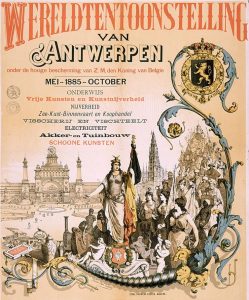 the ages, or was it re-introduced in the 19th century, a bit like Medieval ‘crabbeleire‘ beer that was brought back to the market in Gent in 1847 by brewer Vanderhaegen?[14]
the ages, or was it re-introduced in the 19th century, a bit like Medieval ‘crabbeleire‘ beer that was brought back to the market in Gent in 1847 by brewer Vanderhaegen?[14]
In any case, keute indeed must have disappeared after 1870. The three brewers from Namur that showed their products at the 1885 World Fair in Antwerp made beers like ‘saison namuroise (type local)’, ‘double’, and even a bottom-fermented ‘Felsen-bier’ (brewer Mosselman du Chenoy had vast cellars in a marble quarry at his disposal).[15] Saison and double, but no keute.
All in all, this means the history of Dutch kuit beer can be slightly rewritten: kuit did not end as a measly small beer in Haarlem, but as a saison-like party beer in Wallonia! Even more so: in 2013, the Campaign Dutch Beerstyles relaunched Medieval Dutch kuit beer, but already in 1975 the ‘Confrérie des Chevaliers de la Tarte et de la Pompe’ from Namur suburb Belgrade had a ‘Vî Keute’ brewed again by the Lefevre brewery in Quenast in the province of Brabant.[16] This ‘Confrérie’ looks like a kind of neighbourhood association with funny 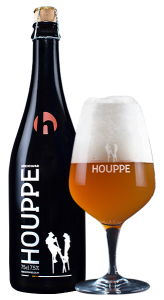 outfits, the type of brotherhood that you often see in Belgium but not in down-to-earth Holland. Anyway, I have a feeling that the recipe of their ‘Vî Keute’ has nothing to do with the real 19th-century (or earlier) keute beer of Namur.
outfits, the type of brotherhood that you often see in Belgium but not in down-to-earth Holland. Anyway, I have a feeling that the recipe of their ‘Vî Keute’ has nothing to do with the real 19th-century (or earlier) keute beer of Namur.
During my visit to Namur I wasn’t able to find any Vî Keute, and maybe it went out of production. But in the meantime, another Namur beer has been revived, at least in name: the new microbrewery L’Echasse has christened its only beer ‘Houppe’.[17] So, when in Namur (for instance for the Brussels Beer Challenge) and not able to trace any keute, just have a houppe…
[1] J. Borgnet en Stanislas Bormans, Cartulaire de la commune de Namur. Tome second, période des comtes particuliers 1118-1430, Namen 1873, p. 171; Marc Libert, La bière et la brasserie à Namur de 1376 à 1606, Louvain-la-Neuve 1985 (scriptie), p. 47. Cf. J. Grandgagnage, Coutumes de Namur et coutume de Philippeville, Brussel 1870, p. 441.
[2] Libert, La bière et la brasserie à Namur, p. 40.
[3] Stanislas Bormans, Cartulaire de la commune de Namur. Tome troisième, période Bourguignonne 1429-1555, Namen 1876, p. 162.
[4] Libert, La bière et la brasserie à Namur, p. 40, 46-48.
[5] Cf. Raf Meert’s article, https://lambik1801.wordpress.com/2014/02/25/hals-bier-uit-1559-is-geen-lambik-deel-2/; Jef Van den Steen, Geuze & kriek. Het geheim van de lambik, Tielt 2011, p. 12.
[6] Libert, La bière et la brasserie à Namur, p. 46.
[7] Vincent Tavier, ‘Le commerce de la bière à Namur entre 1606 et 1794’, in: Annales de la Société archéologique de Namur, deel 67 nr. 1 (1991), p. 41-56.
[8] Vincent Tavier, ‘ La corporation des brasseurs à Namur (1606-1794)’, in: Jacques Toussaint (red.), Corporations de métiers à Namur au XVIIIe siècle, Namen 1998, p. 117-126.
[9] Félix Rousseau, Légendes et coutumes du pays de Namur, Brussel 1971, p. 179-180. (Re-edition of a book from 1920.)
[10] L’Indépendance Belge 8-5-1892.
[11] https://fr.wikipedia.org/wiki/Viv_Nameur_po_tot; L. Maréchal, ‘La vie de nos grands-pères évoquée par la chanson’, in: Le guetteur Wallon, volume 4 nr. 11 (1927), p. 253-260.
[12] Rousseau, Légendes et coutumes.
[13] G. Lacambre, Traité complet de la fabrication des bières et de la distillation des grains, part 1, Brussels 1851, p. 320-321.
[14] Gazette van Brugge 21-6-1847, 25-6-1847.
[15] Exposition Universelle d’Anvers 1885 sous le haut patronage de sa majesté le roi des Belges. Catalogue de la section Belge, Brussel 1885, p. 190, 194, 200; Moniteur de la Brasserie de Bruxelles 1880, p. 122-126, can be read on http://users.skynet.be/artemisia/briecongres.htm.
[16] http://www.cctpbelgrade.be/. It has also been brewed by Brasserie du Bocq in Purnode, unfortunately I don’t know who was first.
[17] http://www.houppe.be/fr/la-bibine/






[…] Van Uytven R., Geschiedenis van de dorst; Lost Beers […]